Has anyone done any kind of test or academic study with an antique or replica of a military grade Renaissance arbalest? I know a couple of the very heavy prods (circa 1000 lb draw strength) have been made, at least one in the US and one in Europe, but I never heard about any tests actually being done. Anybody know about any?
J
Jean Henri Chandler wrote
I have a client who is looking into this at present and believes that you are correct in that no testing has been done to date. With this in mind he has ordered a circa 900-950lb bow that will be delivered in a couple of weeks with the express pupose of doing testing.
If I learn anything I will let you know.
Tod
| Quote: |
| Has anyone done any kind of test or academic study with an antique or replica of a military grade Renaissance arbalest? I know a couple of the very heavy prods (circa 1000 lb draw strength) have been made, at least one in the US and one in Europe, but I never heard about any tests actually being done. Anybody know about any?
|
I have a client who is looking into this at present and believes that you are correct in that no testing has been done to date. With this in mind he has ordered a circa 900-950lb bow that will be delivered in a couple of weeks with the express pupose of doing testing.
If I learn anything I will let you know.
Tod
I would really appreciate that, thanks Todd.
You are one of the people who makes prods of this strength, correct? Do you know how many others there are around the world? I seem to remember there was one guy in Texas and another guy in Eastern Europe somewhere...?
J
You are one of the people who makes prods of this strength, correct? Do you know how many others there are around the world? I seem to remember there was one guy in Texas and another guy in Eastern Europe somewhere...?
J
Well here is some very unscientific info.
The bow is 850lb and shoots a 65g bolt. The steel is .2-.25% carbon and was shot at 15 yds with the steel directly on a straw boss as a backing.
The steel was only 1.6mm thick but as they were the clients bolts I did not want to risk any damage to them.
I did not shoot the bow for distance but I would expect about 230-250 yds with this bolt and a lighter bolt maybe another 30-50yds.
The strings on my bows are very heavily waxed to cut down on string wear, but this will add considerably to their weight and so reduce efficiency considerably. We may replace the string on this bow with a lightly waxed one for testing.
I have handed the bow over now and so what the client does with it as regards testing is out of my hands, but if I find out anything I will either post it up or ask if he could.
On another note, it does seem that we do not know definitively if arrow/bolt heads were hardened or not, however case hardening was known about and easy to do in volume batches, so I am pretty sure they would have done this and so with this in mind I will sooner or later make some bolts up with about .8% carbon heads at near full hard and properly sharp and see what difference this makes.
Tod
 Attachment: 153.66 KB
Attachment: 153.66 KB
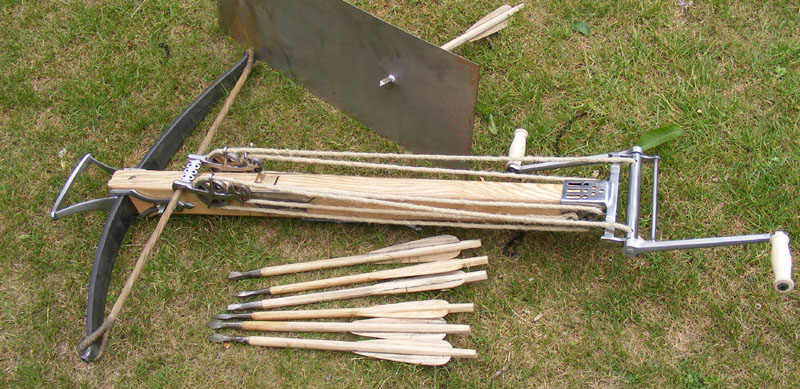
 Attachment: 122.13 KB
Attachment: 122.13 KB
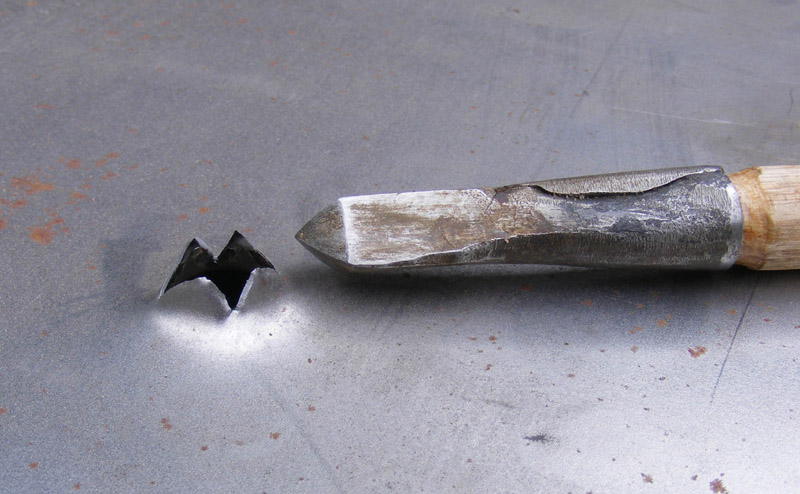
 Attachment: 142.73 KB
Attachment: 142.73 KB
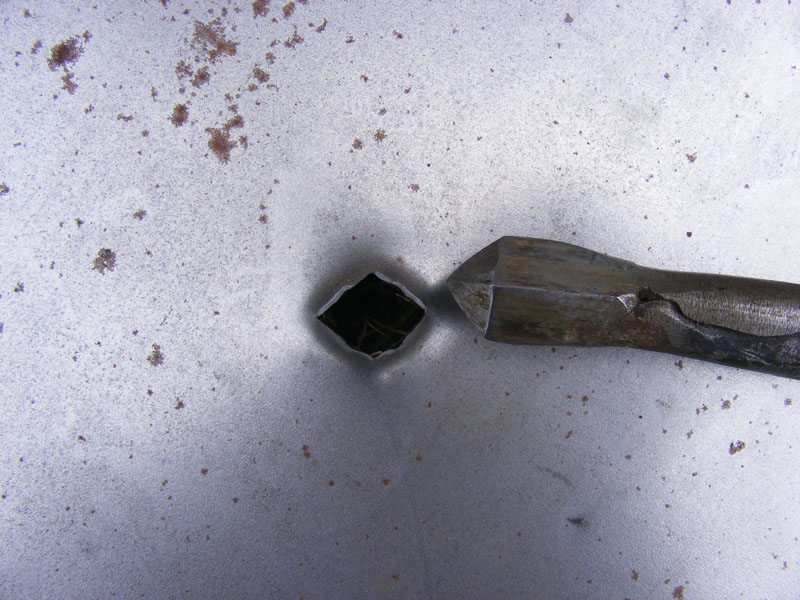
The bow is 850lb and shoots a 65g bolt. The steel is .2-.25% carbon and was shot at 15 yds with the steel directly on a straw boss as a backing.
The steel was only 1.6mm thick but as they were the clients bolts I did not want to risk any damage to them.
I did not shoot the bow for distance but I would expect about 230-250 yds with this bolt and a lighter bolt maybe another 30-50yds.
The strings on my bows are very heavily waxed to cut down on string wear, but this will add considerably to their weight and so reduce efficiency considerably. We may replace the string on this bow with a lightly waxed one for testing.
I have handed the bow over now and so what the client does with it as regards testing is out of my hands, but if I find out anything I will either post it up or ask if he could.
On another note, it does seem that we do not know definitively if arrow/bolt heads were hardened or not, however case hardening was known about and easy to do in volume batches, so I am pretty sure they would have done this and so with this in mind I will sooner or later make some bolts up with about .8% carbon heads at near full hard and properly sharp and see what difference this makes.
Tod



Cool photos, Leo!
Great that someone spends some time, effort and money to do some experiments, even "unscientific" ones. :cool:
Great that someone spends some time, effort and money to do some experiments, even "unscientific" ones. :cool:
Man Leo wish I were around to see that one! Some day when I have a little money I want to have you make me a crossbow.
Do keep us posted on how things go. I'd be interested to hear what the unhardened verse hardened heads do.
RPM
Do keep us posted on how things go. I'd be interested to hear what the unhardened verse hardened heads do.
RPM
Thanks so much for sharing this Tod.
I'll note that while the plate was penetrated the bolt didn't get far enough through to badly injure someone wearing that plate.
I was thinking about how to set up a better test and I figure you could use several layers to test both penetration and damage to the hypothetical person underneath.
First layer armour of various types.
Next padding and clothing type textiles as appropriate.
Then tatami to simulate muscle and flesh.
Last wooded board to simulate bone.
My thought is that a test like this would demonstrate how difficult/unlikely it is to severely damage the flesh or bone underneath the armour, padding and clothes.
Keep up the good work.
Cheers,
Steven
I'll note that while the plate was penetrated the bolt didn't get far enough through to badly injure someone wearing that plate.
I was thinking about how to set up a better test and I figure you could use several layers to test both penetration and damage to the hypothetical person underneath.
First layer armour of various types.
Next padding and clothing type textiles as appropriate.
Then tatami to simulate muscle and flesh.
Last wooded board to simulate bone.
My thought is that a test like this would demonstrate how difficult/unlikely it is to severely damage the flesh or bone underneath the armour, padding and clothes.
Keep up the good work.
Cheers,
Steven
Good idea, but between the "meat" and the padding I would like to see some device to measure the force of the impact. Or its possibile to calculate it?
Last edited by Gabriele A. Pini on Thu 24 Jun, 2010 8:49 am; edited 1 time in total
| Leo Todeschini wrote: |
|
I did not shoot the bow for distance but I would expect about 230-250 yds with this bolt and a lighter bolt maybe another 30-50yds. I will sooner or later make some bolts up with about .8% carbon heads at near full hard and properly sharp and see what difference this makes. Tod |
Just my own little obsession here, but I would find it very interesting to see what happens if one tries to see what happens with very VERY heavy bolts ? As discussed on other Topics threads about crossbow bolts and heavy draw weights the prod can only move so fast even when the draw weight is very high and one can reach a point of diminishing returns where more draw weight doesn't increase the prod/string speed doesn't increase and may even decrease with a heavier mass prod.
But the ratio of mass between prod and bolt make that a heavier draw weight means that a very heavy bolt's mass won't slow down string speed very much and that for example a bolt at twice the mass may lose only a tiny percentage of speed compared to a lighter bolt and that an extremely underweight bolt won't go any faster since the prod/string speed is limited by it's maximum return speed without a bolt ( not recommended since dry firing can damage the prod ).
Anyway, Tod I know you already know the argument but I repeated it here for the sake of others who haven't read or don't remember previous discussions on the same subject.
In any case there is an optimum draw weight/prod speed/bolt mass for any specific crossbow that results in the maximum momentum imparted to the bolt ( not speed or kinetic energy which is more a factor at bullet speeds over 1000 ft/sec. as I believe that at the lower speeds around 150 to 200 ft/sec momentum is more important so the mass of the projectile if doubled gives a lot more momentum than a small increase in velocity and kinetic energy ).
Now the weight of the bolts may be already optimum for this crossbow and/or historically correct but historically did they understand that making the draw weight extremely heavy did very little to increase the efficiency of and underweight sub-optimum mass bolt ? ( I assume that by empirical experience they would have used the best bolt weight to prod draw weight but would not know the actual math involved. I also assume they would know a lot more than we do about how to get the best performance out of a crossbow. ;) ).
I seem to remember an article from about 10 or 15 years ago where they compared some period crossbows and firearms to modern firearms as far as muzzle velocity and such. No Idea how scientific it was. My guess is it was in one of the gun mags.
Best
Craig
Best
Craig
Leo,
Thanks so much for posting. Very interesting.
Did you have any other observations from your informal tests? How would you compare the power of this 850 lb draw weapon with a modern hunting crossbow? Or a longbow?
If your client shares his test results with you, can you share them with us? Id like to know the speed and 'muzzle energy' of this weapon.
J
Thanks so much for posting. Very interesting.
Did you have any other observations from your informal tests? How would you compare the power of this 850 lb draw weapon with a modern hunting crossbow? Or a longbow?
If your client shares his test results with you, can you share them with us? Id like to know the speed and 'muzzle energy' of this weapon.
J
Last edited by Jean Henri Chandler on Thu 24 Jun, 2010 12:33 pm; edited 1 time in total
Jean Thibodeau wrote
I think the last lines are it in a nutshell they didn't have the maths, but they had the empirical knowledge. They saw again and again what worked and what did not and so focussed in on what worked. As far as I know there are no bolts in existance that we can categorically say were for a particular bow so we can only guess at what they shot with what, but the bolts that have armour piles are typically 60-70g in weight (about what these are) so I have to take this as a start point.
I am quite getting into bows these days and know the actual poundages of the bows I make rather than estimated, guessed or calculated which is a good start point. I really need to know the impact energy and with this in mind I will before too long make up a ballistic pendulum and test shoot bows as I make them so that after a while I can start to get some hard information on energy delivery. I guess I am sailing close to the advertising wire here, which is not my intention, it is just that I am in a very privilaged situation where I handle many bows of different weights, I am just short of the time to turn that into useful information - but it will come.
When I do make a pendulum I will post up the information as I test shoot bows.
Jean as a present to you I will put a piece of 1/2" x 15" steel bar on my 700lb bow and see what it does - if anything. I will get back to you
Tod
| Quote: |
| Now the weight of the bolts may be already optimum for this crossbow and/or historically correct but historically did they understand that making the draw weight extremely heavy did very little to increase the efficiency of and underweight sub-optimum mass bolt ? ( I assume that by empirical experience they would have used the best bolt weight to prod draw weight but would not know the actual math involved. I also assume they would know a lot more than we do about how to get the best performance out of a crossbow. ).
|
I think the last lines are it in a nutshell they didn't have the maths, but they had the empirical knowledge. They saw again and again what worked and what did not and so focussed in on what worked. As far as I know there are no bolts in existance that we can categorically say were for a particular bow so we can only guess at what they shot with what, but the bolts that have armour piles are typically 60-70g in weight (about what these are) so I have to take this as a start point.
I am quite getting into bows these days and know the actual poundages of the bows I make rather than estimated, guessed or calculated which is a good start point. I really need to know the impact energy and with this in mind I will before too long make up a ballistic pendulum and test shoot bows as I make them so that after a while I can start to get some hard information on energy delivery. I guess I am sailing close to the advertising wire here, which is not my intention, it is just that I am in a very privilaged situation where I handle many bows of different weights, I am just short of the time to turn that into useful information - but it will come.
When I do make a pendulum I will post up the information as I test shoot bows.
Jean as a present to you I will put a piece of 1/2" x 15" steel bar on my 700lb bow and see what it does - if anything. I will get back to you
Tod
Todd, do you make any high draw weight bows designed for use with a cranequin instead of a windlass?
Something like one of these?
http://www.wga.hu/art/h/holbein/hans_e/sebastia.jpg
http://www.artfinding.com/images/lot/_240/pet...443492.jpg
J
Something like one of these?
http://www.wga.hu/art/h/holbein/hans_e/sebastia.jpg
http://www.artfinding.com/images/lot/_240/pet...443492.jpg
J
| Leo Todeschini wrote: |
|
Jean as a present to you I will put a piece of 1/2" x 15" steel bar on my 700lb bow and see what it does - if anything. I will get back to you Tod |
That would be nice. :) :cool:
Be careful about how it leaves the string and doesn't jump off the string in a weird and dangerous way. ;) ( Flies forward and not go strait up and back down ! ? )
Just a thought - why using? tatami or the straw - there is an easy way to simulate flesh - with real flesh and bones. I mean to use a dead animal, like swine or pig (it has moreless the same density and construction as human muscle).
The most important would be to have it fattened and wet, so that the muscles wouldn't tighten too much.
The other thing is the way of attaching the steel and cloth to the meat - I mean the way how would the entire armour behave on that animal while being hit by the bolt.
Another thought is how to reproduce the momentum caused by the movement and mass of a knight (or soldier) that is approaching the shooter by foot or by the horse. With such mass (especially with the horse) the hit is empowered many times, causing the hit to be much more efficient.
what do you think?
The most important would be to have it fattened and wet, so that the muscles wouldn't tighten too much.
The other thing is the way of attaching the steel and cloth to the meat - I mean the way how would the entire armour behave on that animal while being hit by the bolt.
Another thought is how to reproduce the momentum caused by the movement and mass of a knight (or soldier) that is approaching the shooter by foot or by the horse. With such mass (especially with the horse) the hit is empowered many times, causing the hit to be much more efficient.
what do you think?
Hi All,
Well following up on my offer to Jean, I have something to report.
I made a steel 'bolt' from a 350mm long x 12mm (14" x 1/2") diameter four face sharp at the point with a taper behind the head and thinned down at the back to fit into the nut.
I shot from a 700lb bow into the same steel as I shot from the 850lb but at about half a meter as the bolt was likely to tumble so the further away I was the less likely I was to get a clean hit.
The steel bolt faces were slightly smaller than the normal bolt but the penetration was far less, with the steel bolt bouncing out without full penetration.
So it is fair to say that there were some differences between the bows, 150lb weight for one, but the difference in performance of the bolts was drastic so in a crude way we can conclude that Jeans musings on the effectiveness of a very heavy bolt has an answer. If you want high impact energies you need the classically weighted/proportioned bolt and that a very heavy bolt in fact has lower impact energy.
The pictures show the same steel from the shots at the beginning of this thread, the larger hole being the hole created with the wood/steel bolt and the smaller hole being from the all steel bolt. The bow used was my own rather than a customers and is pretty similar to the bow at the beginning.
Jerzy Miklaszewski suggested various tests and mediums for testing and much as I am interested in pursuing testing properly, until I can secure a nice grant to cover my time and costs I now have to pop off to the workshop and earn some money.
Tod
 Attachment: 119.55 KB
Attachment: 119.55 KB
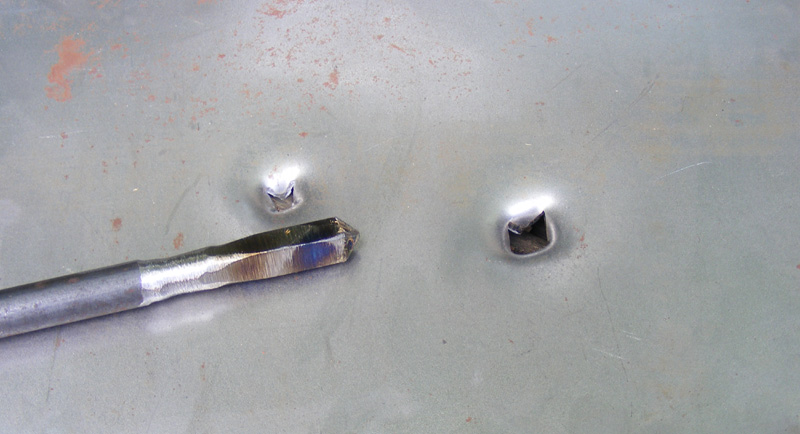
 Attachment: 131.07 KB
Attachment: 131.07 KB
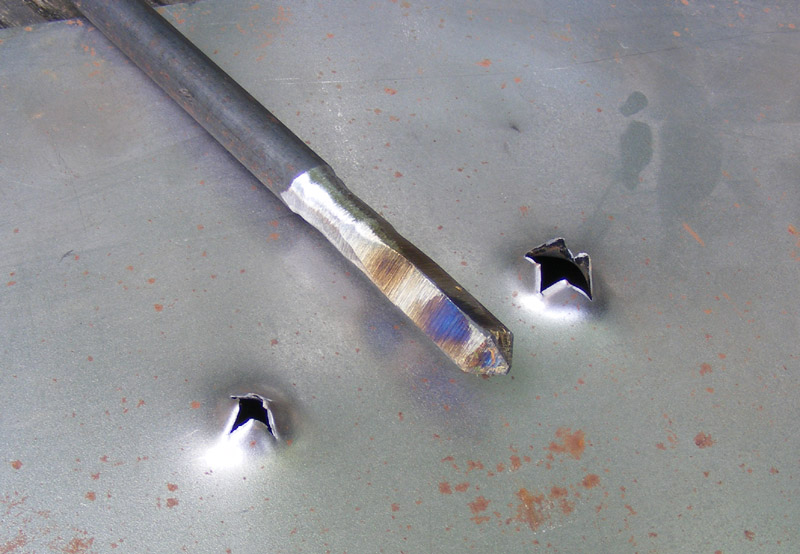
 Attachment: 130.84 KB
Attachment: 130.84 KB
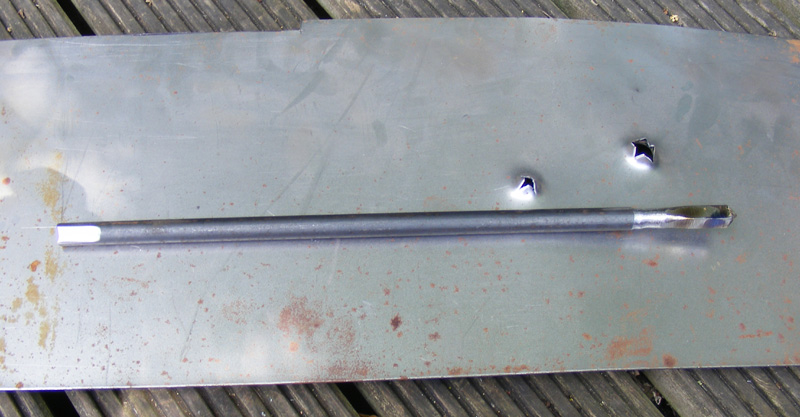
Well following up on my offer to Jean, I have something to report.
I made a steel 'bolt' from a 350mm long x 12mm (14" x 1/2") diameter four face sharp at the point with a taper behind the head and thinned down at the back to fit into the nut.
I shot from a 700lb bow into the same steel as I shot from the 850lb but at about half a meter as the bolt was likely to tumble so the further away I was the less likely I was to get a clean hit.
The steel bolt faces were slightly smaller than the normal bolt but the penetration was far less, with the steel bolt bouncing out without full penetration.
So it is fair to say that there were some differences between the bows, 150lb weight for one, but the difference in performance of the bolts was drastic so in a crude way we can conclude that Jeans musings on the effectiveness of a very heavy bolt has an answer. If you want high impact energies you need the classically weighted/proportioned bolt and that a very heavy bolt in fact has lower impact energy.
The pictures show the same steel from the shots at the beginning of this thread, the larger hole being the hole created with the wood/steel bolt and the smaller hole being from the all steel bolt. The bow used was my own rather than a customers and is pretty similar to the bow at the beginning.
Jerzy Miklaszewski suggested various tests and mediums for testing and much as I am interested in pursuing testing properly, until I can secure a nice grant to cover my time and costs I now have to pop off to the workshop and earn some money.
Tod



Heavier bolt SHOULD have more energy. But there is one big BUT. Heavy bolt moves slower which means that padding is more effective. Imagine having your bolt attached to a heavy truck moving at 5 mph. It has an enormous amount of energy, but it will knock the target down without penetrating it. On the contrary, a rifle bullet, which has less energy, will punch a hole in the steel even if you hang it without anything behind it.
Thanks for the test and it does seem to show that heavier is not necessarily better but there might still be a few questions to answer " eventually " ;) ( I don't expect Leo to spend all his time doing extensive tests. :cool: ).
A few issues:
A) The heavy bolt seems to be very unstable and I guess a real bolt meant for serious use would have to be heavy and balance sufficiently to fly true to a reasonable range.
B) This was a test of an extreme weight and may have crossed over way past the crossover point where the extra weight reduced velocity to such a degree as to result in maybe a lot of momentum but too little velocity ? ( Aleksei's example of extreme momentum but very low speed means more of a heavy push than penetration ).
C) Where a bolt would be optimized for effect on target might mean that the bolt could be heavier than the original bolts made by Leo but the weight might be optimum at only 5% - 10% - 20% ................ XX% more. ( Or already optimum ).
A test in the other direction of an extremely light bolt would also give a result showing an inefficient bolt I assume.
So, I'm not completely abandoning the idea that " maybe " our reproduction of period bolts are a bit too light but I am now convinced that a 2X - 3X - 4X or more weight bolt is way beyond the optimum weight.
Leo thanks very much for the test as it does at least show the effects of really overdoing it in one direction that show a loss of effectiveness. ;) :D :cool:
A few issues:
A) The heavy bolt seems to be very unstable and I guess a real bolt meant for serious use would have to be heavy and balance sufficiently to fly true to a reasonable range.
B) This was a test of an extreme weight and may have crossed over way past the crossover point where the extra weight reduced velocity to such a degree as to result in maybe a lot of momentum but too little velocity ? ( Aleksei's example of extreme momentum but very low speed means more of a heavy push than penetration ).
C) Where a bolt would be optimized for effect on target might mean that the bolt could be heavier than the original bolts made by Leo but the weight might be optimum at only 5% - 10% - 20% ................ XX% more. ( Or already optimum ).
A test in the other direction of an extremely light bolt would also give a result showing an inefficient bolt I assume.
So, I'm not completely abandoning the idea that " maybe " our reproduction of period bolts are a bit too light but I am now convinced that a 2X - 3X - 4X or more weight bolt is way beyond the optimum weight.
Leo thanks very much for the test as it does at least show the effects of really overdoing it in one direction that show a loss of effectiveness. ;) :D :cool:
Last edited by Jean Thibodeau on Mon 28 Jun, 2010 2:59 pm; edited 1 time in total
Testing with a 150lb longbow showed that the kinetic energy increased the heavier the arrow got. The maximum in this case was four ounces. Lighter bows show even higher efficiencies with more grains per pound of draw weight. If crossbows perform differently, I would be interested in knowing why.
| Benjamin H. Abbott wrote: |
| Testing with a 150lb longbow showed that the kinetic energy increased the heavier the arrow got. The maximum in this case was four ounces. Lighter bows show even higher efficiencies with more grains per pound of draw weight. If crossbows perform differently, I would be interested in knowing why. |
Which set of tests was this? The Defence Academy or Hardy's tests for The Great Warbow?
Page 1 of 19
You cannot post new topics in this forumYou cannot reply to topics in this forum
You cannot edit your posts in this forum
You cannot delete your posts in this forum
You cannot vote in polls in this forum
You cannot attach files in this forum
You can download files in this forum
All contents © Copyright 2003-2006 myArmoury.com — All rights reserved
Discussion forums powered by phpBB © The phpBB Group
Switch to the Full-featured Version of the forum
Discussion forums powered by phpBB © The phpBB Group
Switch to the Full-featured Version of the forum